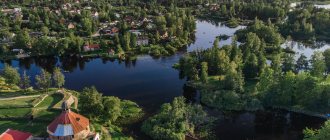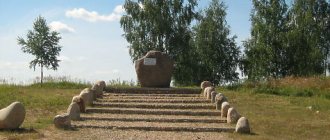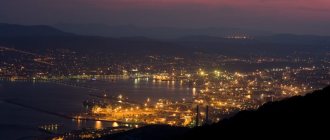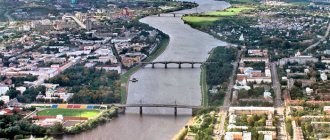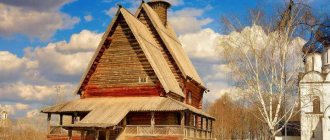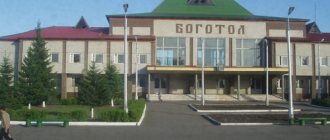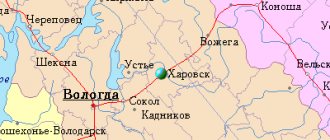Priozersk is a city in the north of the Leningrad region. I have been here many times while passing through on my way to Karelia. Being sure that apart from the fortress, which I visited back in 2010, there was nothing else to see in Priozersk, I always passed through it without stopping - well, except to stop at a gas station and buy all sorts of small things at local grocery stores. I remember that I once asked an acquaintance who lived here to show me the city - so he took me to some industrial zone located on the very outskirts, where he said that there was nothing else interesting in Priozersk. This time, while part of our team went to explore the fortress, which they had never been to before, I finally managed to look around a little. Previously, it seemed to me that Priozersk was completely rebuilt after the Second World War, and these days it should be an ordinary faceless Soviet regional center, built up with standard five-story buildings. But no! Some pre-war Finnish buildings, including wooden ones, have been quite preserved here. Come on, I'll show you!
One of the ancient legends says that Prince Rurik died on the site of present-day Priozersk in 879 (according to another legend, his grave is Shum Mountain in the Novgorod region).
There is no reliable written evidence about the time when the first settlement appeared on the shore of Lake Vuoksa (in ancient times it was known as Uzerva). Archaeologists believe that this happened no later than the 12th century. It is known that in 1295 a certain fortified point, located at the mouth of the Vuoksa, was plundered by Swedish knights who came here from the newly founded Vyborg.
The fortress that appeared here in the 13th century was traditionally called Korela in Russian chronicles. At that time, the fortification was the administrative center of the Korelia land, the prototype of modern Karelia. The Swedes called Korela Kexholm (from the Swedish Kexholm - “Cuckoo Island”), and from 1611 to 1918 the city was known by this name. In 1918, Finland, which gained independence, of which it was a part, renamed it in its own way - Käkisalmi (from Finnish Käkisalmi - “Cuckoo Strait”). Since 1948, the city received its modern name - Priozersk.
The main city attraction is the Korela fortress. In the Middle Ages, this fortification was the most northwestern outpost of Rus'. Today, the fortress has been restored, and a historical museum is located on its territory.
This is what Korela looks like from a bird’s eye view (thanks to Anna Toporkova for the photo from a quadcopter). The endless blue in the background is Lake Ladoga.
View in the other direction - towards Lake Vuoksa. Before the appearance of the Losevskaya channel in the middle of the 19th century, the water level here was one and a half meters higher, and Korela was surrounded by water on all sides.
The central square of Priozersk is expectedly named after Lenin (in the past - Kauppatori, from Finnish Kauppatori - “Market Square”).
Old Finnish buildings have been partially preserved in the city center. For example, this building was built shortly before the Winter War in 1939. It was called “seurahuone”, a word that used to be used in Finland to designate multifunctional public buildings.
The distinctive house with a red tiled roof is a former Scandinavian bank built in 1925. Now this building houses the St. Petersburg Bank. We tried to get inside to photograph the tiled stoves preserved there, but were ingloriously kicked out by bank tellers. Well, nothing is sacred!
Next to the bank is another old Finnish building.
In 1930, a stone church was built in the city.
Next to it is the Spartak city court. Yes, yes, they play gorodki here.
An espalanda, a traditional city park for Finnish cities, stretches from the central square to the northeast, bounded by streets on both sides. In Priozersk these are Lenin and Kalinin streets (oh, those Soviet toponyms).
In the middle of the park stands one of the most unexpected monuments - the sculpture “Panther Bagheera and Mowgli”, which appeared here in Soviet times.
A couple of blocks from the central square, the old wooden buildings are partially preserved. By the way, these days it is unexpectedly in pretty good condition.
A local masterpiece of wooden architecture is the city railway station.
This building was built in 1916.
For some reason, the station waiting room is disfigured by a wretched plastic entrance. I can’t wait until we introduce fines for damaging old wooden buildings with cheap plastic double-glazed windows and other foreign elements.
That's all about Priozersk.
Fortress-Museum "Korela"
Tank IS-3 model 1945 on the pedestal of the memorial to soldiers-liberators:
The Korela fortress is the main attraction of Priozersk. It was founded by the Novgorodians in the 13th-14th centuries for protection from the Swedes. However, in 1580, “Korela” was taken by Swedish troops. As part of Sweden, the city was named Kexholm. Later, the city and the fortress would be returned to Russia, then given back to the Swedes, and in 1721 (under the terms of the Nystadt Peace Treaty) Kexholm became part of the Russian Empire. In 1811, Kexholm was assigned to the Grand Duchy of Finland, which after the 1917 revolution would become independent Finland. This will begin the short Finnish period (at this time the city was called Käkisalmi), which will end in 1940 (except for the occupation by Finnish troops of 1941-1944). In the same year, the Priozersky district was formed. By the way, the city became Priozersk not immediately, but in 1948. Before this, the historical Swedish name Kexholm was returned to it in the USSR.
Not long ago, in the Leningrad region, “tags” with the hashtag #myalenoregion appeared near some attractions - a good start.
The building of the New Arsenal on the territory of the fortress is now a local history museum:
A bench nearby (especially fingers on the armrests):
The fortress is located on an island in the Vuoksa River:
Under the bastion there is a landscaped park:
The calling card of the Korela fortress is the round Gate Tower (also known as the Pugachev Tower) built by the Swedes in 1585:
On the left is the Old Arsenal (built in 1591):
The fortress museum is a must-visit; the payment is purely symbolic - 60 rubles (or 100 rubles for a single ticket, with which you can view the displays and exhibitions).
I never cease to admire the landscaping (this path leads to the fortress):
But let's return to the city. Old and new signs:
A former dacha built in 1920, now the editorial office of the Krasnaya Zvezda newspaper:
Travel under the railway track:
Lake Vuoksa begins behind the railway line:
There is a boat station and a motorboat club on the lake:
“Stalinist” two-story houses on Privokzalnaya Street:
The landscaping is not just swans made of tires, but also with a fountain. It works from an extension cord lowered from the apartment window, amazingly:
Beeline-sponsored clock on Vokzalnaya Square:
Population and administrative structure
The population of the Priozersky district is 62 thousand people. The last 8 years have been approximately at the same level, the minimum in the modern history of Russia was recorded in 2009 - 59.4 thousand people, and the maximum in 2013 - 63.1 thousand. Indicators before 2006 can be ignored, since the population of the city of Priozersk was not taken into account. 37% of the population live in urban areas, which is significantly lower than the average urbanization rate for the Leningrad region.
It consists of the Kuznechnoye municipality (2 settlements and 4,300 population), the Priozersk urban settlement (4 settlements and 18.9 thousand population) and twelve rural settlements. All of them include a total of 103 settlements.
Table. Rural settlements of the Priozersky district
| Name | Center | Population | Settlements included |
| Gromovskoye | Gromovo village | 2500 | 12 |
| Zaporozhye | Zaporizhskoe village | 2780 | 7 |
| Krasnozernoe | Village Krasnozernoye | 1120 | 5 |
| Larionovskoe | Village Larionovo | 2850 | 12 |
| Melnikovskoe | Melnikovo village | 2000 | 8 |
| Michurinskoe | Michurinskoe village | 1850 | 2 |
| Petrovskoe | Petrovskoe village | 1820 | 6 |
| Plodovskoe | Plodovoye village | 2800 | 12 |
| Razdolevskoe | Village Razdolie | 1650 | 5 |
| Romashkinskoe | Village of Romashki | 7400 | 10 |
| Sevastyanovskoe | Sevast'yanovo village | 750 | 9 |
| Sosnovskoe | Sosnovo village | 11360 | 9 |
Priozersk railway station
Another must-see attraction of Priozersk is the miraculously preserved wooden station building, built in 1916. The architecture is unusual - compare at least with the photo of the lost Sortavala station building. After restoration in 2008, the building was restored to its historical appearance.
Inside, the impression is slightly spoiled by typical plastic doors and benches, but overall it’s very beautiful:
Electric train ET2EM-002 “Vuoksa” at Priozersk station:
Another representative of Priozersk buses is the rather rickety LiAZ-5256.23-01:
Residential buildings opposite the station:
Graffiti in the courtyards:
There are many interesting wooden houses in Priozersk:
How to get to Priozersk
You can get to Priozersk by several means of transport:
- by car: from St. Petersburg on the A129 highway it takes about 2 hours;
- by train or commuter train: the journey from Finlyandsky Station in St. Petersburg takes about 3 hours;
- by bus No. 859 or 960 from St. Petersburg: the ride takes about 3 hours.
The most convenient trains are:
- St. Petersburg - Kuznechnoye (express);
- St. Petersburg - Kostomuksha (long-distance train).
The most convenient, but most expensive way is a taxi. You can get to Priozersk on it from almost any city; in this case, the fare is calculated either by travel time or by mileage. I had to get to different cities by taxi, sometimes due to a lack of tickets (for example, I went from Penza to Samara for the New Year holidays). All the offices where I inquired about the cost of travel politely offered to pay for the carrier’s services in advance. Moreover, the cost is calculated for the taxi driver’s round trip.
Priozerskaya church
The Finnish church built in 1930 is in an abandoned state. After the war, the NKVD department and, as usual, the House of Culture were located here.
In 2001, a disco with a bar was placed in the once Lutheran church, and in 2002 there was a severe fire.
They want to restore the building, I hope this will happen soon.
An interesting legacy of the Finnish period remains on the outskirts of Priozersk. This is the former Waldhof Ab plant:
The plant was nationalized after the war and became the Priozersk Pulp and Paper Mill. The plant was closed in 1986 due to environmental threats.
I decided to complete my visit to Priozersk by visiting the shores of Lake Ladoga. The road goes past the plant, residential buildings and then turns into a dirt road past the forest.
The view near the shore is so-so, but there could be a wonderful walking area - the city is very close.
Road
The A-121 Sortavala highway leads from St. Petersburg to Priozersk and further to Sortavala. It is currently being actively reconstructed. Part of the road is a modern four-lane highway, two lanes in each direction, with a median, reflectors and lighting in certain areas.
Reconstructed highway A-121 “Sortavala”
Closer to Priozersk it ends and turns into an older two-lane road. Finally, beyond Priozersk to the border with Karelia there is a very winding dirt road (the asphalt has apparently been washed away). Next to it, construction of a new highway is underway at an accelerated pace, so that in a few years it will be possible to travel from St. Petersburg to Sortavala in a breeze.
Construction of the A-121 Sortavala highway near Berezovo (August 2018)
Ladoga lake
At the end of the post there are a few photos of Lake Ladoga.
Still, it’s worth driving here, even if it’s on a bad dirt road, the scenery here is magnificent:
What to see depending on the time of year
The sights of Priozersk delight tourists in all seasons. In summer it is green and romantic, in autumn and spring it is colorful, and in winter it is cool and magical. In addition, in different seasons Priozersk entertains its guests with events:
- Leningrad Region Day (July 28);
- sports and tourism festival “Ladoga Fest” (August);
- military-historical reconstruction festival “Kexholm Garrison” (September);
- ethnocultural festival of the Leningrad region.
Day of the Leningrad Region in the Priozersky District
Priozer residents respect the history of their region, so they actively take part in the regional holiday. On the region’s birthday, the Priozersk Philharmonic Society opens its doors to fans of official events, events are held on the streets and children’s playgrounds are open with games and competitions. During the celebration, you can not only take a walk and watch street concerts, but also learn more about the history of Priozersk and the region.
On the Day of the Leningrad Region, entire families and groups of citizens take to the streets
The celebration begins with a procession through the streets of the city, and the ceremonial part of the holiday takes place in the Philharmonic.
Sports and tourism festival "Ladoga Fest"
Ladoga Fest is a major international sports tourism festival. The authorities of the Leningrad region decided that Priozersk would be the birthplace of the new holiday (it will take place for the first time in 2022). The festival will last 9 days, and athletes from different cities and regions will take part in it.
Several competitions are planned as part of the festival:
- Priozersky Half Marathon (21.1 km);
- athletics mass race for the Cup of the head of the district administration (5 and 10 km);
- two-day King of the Hammers competition and off-road vehicle exhibition;
- sports auto tourism competitions and the “Tailwind” motorcycle festival;
- European gathering of off-road vehicle owners and enthusiasts;
- sports and tourism race Vuoksa Race and a large equestrian festival;
- ring trophy race on SUVs, buggies, ATVs and all-terrain vehicles;
- airsoft game and much more.
During the boat race, those interested will learn the basics of maritime and rigging, the history of shipbuilding, and the design of ships.
Those wishing to attend the festival as a guest or participant must be mobile. The holiday will begin in Priozersk and continue in various festival cities on the coast of Lake Ladoga. The last events will take place in the capital of the festival.
Military-historical reconstruction festival “Kexholm Garrison”
“Kexholm Garrison” is the only international reconstruction festival in Russia dedicated to the Peter the Great era. The first event was held in honor of the 300th anniversary of the liberation of the city in the Northern War. A reenactment is a historical event reenacted by historical actors with some degree of accuracy (the Swedish garrison held the siege for 2 months, but the reenactment of the assault lasts only 1 hour). Reenactors from several countries take part in the festival:
- Russia;
- Sweden;
- Finland;
- Baltic countries, etc.
Viewers can watch the recreated actions of soldiers of Peter the Great's Preobrazhensky Regiment:
- arrangement of the camp;
- drill demonstrations;
- preparing a soldier's lunch in the field;
- training for beginners;
- storming the Korela fortress;
- fighting at the fortress walls;
- surrender of the Swedish army, etc.
Photo gallery: scenes from the Kexholm Garrison reconstruction festival
The festival is dedicated to the 300th anniversary of the liberation of Kexholm in the Northern War, so the parties to the “battle” are Russian and Swedish troops
Actors from Moscow, St. Petersburg, Petrozavodsk, Vyborg, Riga, Narva and Sweden are participating in the reconstruction - all in costumes of the 18th century
A special bonus for the audience is the performance of the military orchestra of Peter the Great’s time. The main event of the festival is the capture of the Kexholm fortress by the troops of Peter I
Festival guests will be able to watch scenes from the life of the Kexholm garrison of the 18th century
The festival venue is the Korela fortress. The date may vary depending on the weather, weekends, etc. (usually the festival is held in the last ten days of September).
Annual ethnocultural festival “Russia - Consonance of Cultures”
“Russia - Consonance of Cultures” is a large-scale ethnocultural festival, which is held annually in different cities of the Leningrad region. This is a multinational holiday in which representatives of different regions of the Northwestern Federal District take part. Colorful festival events take place at several venues:
- festive procession of festival participants;
- interactive performances of nationalities;
- master classes on traditional crafts and national dishes;
- children's games and attractions;
- performances by creative groups.
Photo gallery: some sites of the festival “Russia - Consonance of Cultures”
Delegations from different districts of the region and national and cultural associations take part in the procession
The holiday is accompanied by a large concert with the participation of children's and adult creative groups "National Compounds" - these are exhibitions of traditional applied arts, household items, and national costumes
Each nationality of the region holds its own interactive platform with an exhibition and mini-fair
The festival hosts many master classes in which anyone can take part.
The location of the festival depends on which city acted as the organizer.
How long does it take to explore the city?
The city of Priozersk can be explored in 1 day. It takes more time to visit at least 3-4 islands, and it is the road and crossing that takes a lot of time, and not just getting to know the sights. Although tourists traveling as part of an excursion group barely have time to explore the city and several islands in a day.
Do I need to check into a hotel?
Priozersk is a small town, so there are few hotels here. The most popular among tourists is, perhaps, the Korela Hotel. There is always a free room, the service is unobtrusive, and the services are provided at the proper level. This hotel has the title of “three-star”, but it has free Wi-Fi, laundry, and pets are allowed. Room prices start from 2500 rubles. The Korela Hotel is located on Kalinina Street in the city center.
The Korela Hotel in Priozersk enjoys the trust of tourists with its small but cozy rooms.
Tips for staying in Priozersk
Tourists should consider a few basic tips when preparing for their trip:
- if you are traveling to Priozersk by car, remember the speed limit: in some places the road looks like a mountain serpentine;
- In the evening it is cool near the reservoirs, so you need to take warm clothes with you;
- if you are going to visit wooded areas and parks, do not forget to wear closed clothing that will protect against ticks, mosquitoes and mosquitoes;
- take care of a spare mobile phone: a wet mobile phone is no help;
- Carry a sufficient amount of cash with you: taxi drivers and ferry drivers do not always accept cards;
- Prepare maps of the city, islands and entire region in advance: purchase a paper guide or download a special application.
Photo gallery: useful maps
A map of the islands is needed in order to navigate on the water. No trip is complete without a tourist map.
A map of the area is needed for those traveling by car
